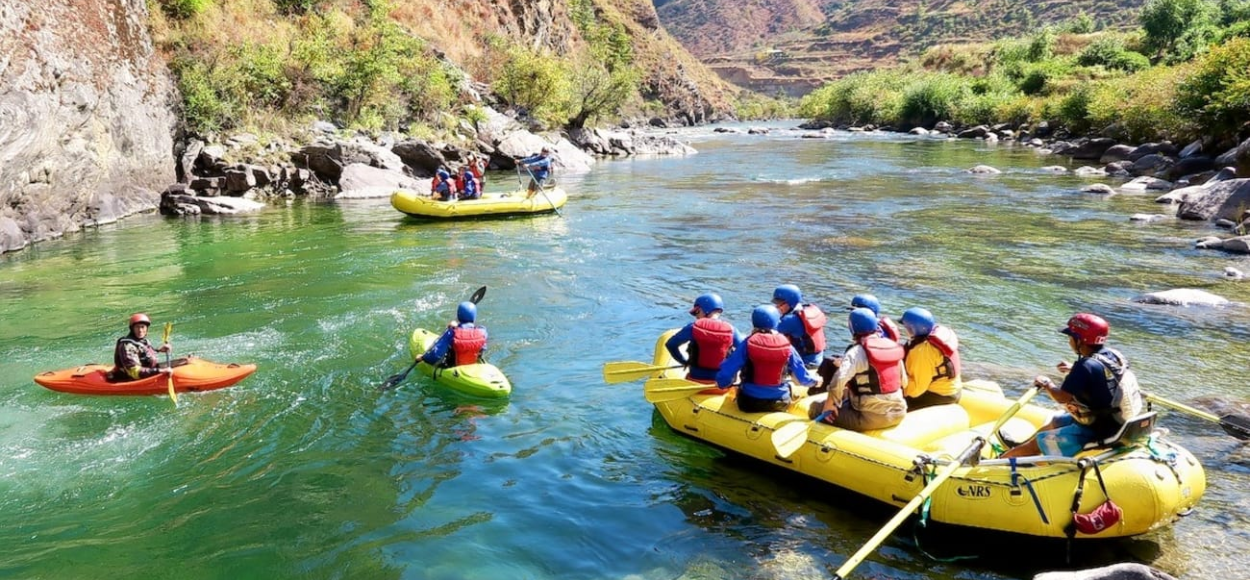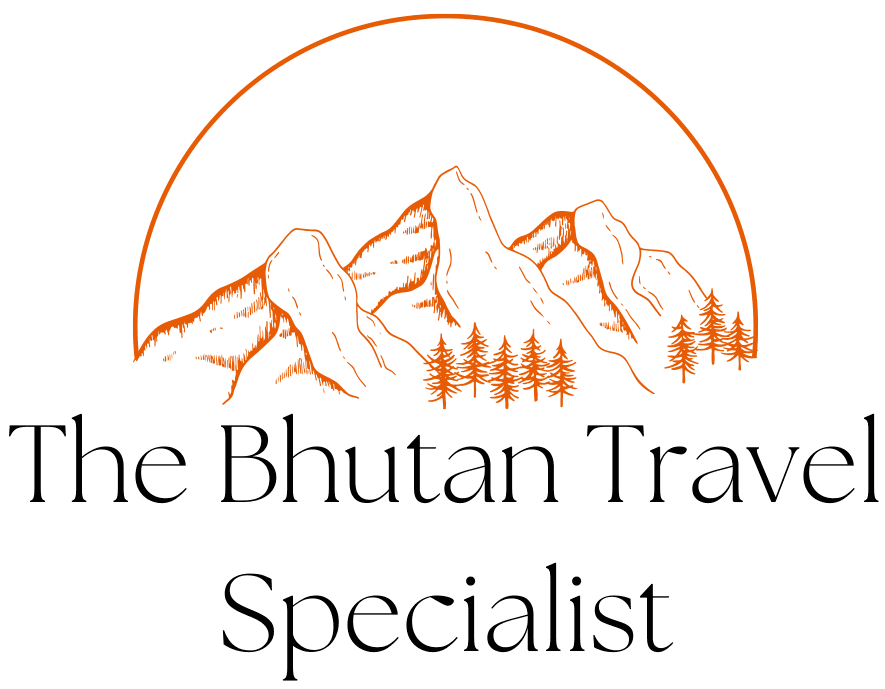Do not hesitate to give us a call. We are an expert team and we are happy to talk to you.
(+975) 17953762

Overview:
Embark on an 8-day White Water Rafting Tour through the pristine landscapes of Bhutan, combining thrilling river adventures with cultural exploration. Begin in Paro, soaring into the picturesque valley, and continue to Thimphu for a day of cultural immersion. Journey to Punakha for exhilarating Bhutan rafting tours on the Pho Chhu and Mo Chhu rivers, surrounded by breathtaking scenery. Explore Punakha’s cultural gems and experience the warmth of the locals. Transfer to Paro for further exploration, including a visit to the iconic Tiger’s Nest Monastery. Conclude your adventure with fond memories of Bhutan’s majestic landscapes and the thrill of white water rafting.
Tour Highlights:
1. Experience the world’s tallest Buddha Statue and a scenic hike in Paro.
2. Thimphu exploration with visits to cultural sites, a Traditional Hot Stone bath, and farmhouse dinner.
3. Scenic drive to Punakha, with stops at Dochula pass and Chhimi Lhakhang.
4. Two days of exhilarating Bhutan rafting tours on the Pho Chhu and Mo Chhu rivers.
5. Explore Punakha’s cultural attractions, including Khamsum Yuelley Namgyal Lhakhang.
6. Visit Rinchengang village and Wangdue Dzong ruins during the rafting tour.
7. Journey to Paro with visits to Tachogang Lhakhang, National Museum, and Paro Dzong.
8. Hike to Paro Taktsang Goemba (Tiger’s Nest Monastery) for a breathtaking view.
9. Explore Drukgyel Dzong and Kyichu Lhakhang in Paro.
10. Leisure time for shopping and relaxation in Paro.
11. Departure from Paro with warm memories of Bhutan’s adventure and culture.
Paro International Airport (Google Map)
Experience the breathtaking beauty of Paro Valley as you soar through the sky and land in Bhutan. Feel the refreshing mountain breeze as our friendly representative welcomes you at the airport. After completing immigration procedures, we’ll whisk you away to your hotel in Thimphu. Before reaching the city, we’ll visit the world’s tallest Buddha Statue and take a scenic hike through lush forests. In the evening, explore Tashichho Dzong and enjoy a delicious dinner. Rest and relax at your hotel.
Embark on a day of exploration in Thimphu. Visit the Memorial Chorten, a magnificent structure built to honor King Jigme Dorji Wangchuck. Inside, you’ll find beautiful examples of tantric Buddhist art. Next, discover the National animal of Bhutan, the Takin, at Mothithang minizoo. Explore Zulikha and Thangtoong Dewachen Nunneries, where Buddhist nuns practice their faith. Get a glimpse of Bhutanese culture at the Folk Heritage Museum and delve into ancient texts at the National Library. In the evening, enjoy a traditional Bhutanese dinner at a FarmHouse and rejuvenate with a Traditional Hot Stone bath. Stay overnight at a hotel or Farm House.
After breakfast, embark on a scenic drive to Punakha. Marvel at the beauty of pine, hemlock, and rhododendron forests along the way. At Dochula pass, soak in the panoramic views of the Eastern Himalayas adorned with small stupas and prayer flags. Descend to the fertile Punakha Valley and visit Chhimi Lhakhang, also known as the temple of fertility. In the evening, indulge in dinner and enjoy the nightlife of Punakha. Prepare for the exciting Bhutan rafting tours ahead. Stay overnight at a hotel.
Get ready for an exhilarating rafting adventure after breakfast. Take a short drive to the river and start your rafting journey towards Punakha Dzong, a stunning fortress located at the confluence of rivers. Capture the awe-inspiring scenery along the way. Enjoy a picnic lunch by the riverside. Afterward, take a drive through traditional villages and farmlands, followed by a short hike to Khamsum Yuelley Namgyal Lhakhang for a breathtaking view of the valley. Stay overnight at a hotel.
After breakfast, embark on the second day of rafting. Hike up to Nyezengong Temple and begin your rafting journey along the picturesque Mo Chhu river. In the evening, visit Rinchengang village in Wangduephodrang, interact with locals, and explore the ruins of Wangdue Dzong. Stay overnight at a hotel.
Enjoy breakfast and embark on a scenic drive to Paro via Dochula pass. Capture stunning views of the Himalayas along the way. Visit Tachogang Lhakhang and cross the thrilling iron chain bridge. After lunch in Paro, explore the National Museum, which houses impressive art collections and relics. Discover the grandeur of Paro Dzong. In the evening, the rest of the day is yours to relax and unwind. Stay overnight at a hotel.
Start your day with breakfast and embark on a short hike to Paro Taktsang Goemba, also known as the Tiger’s Nest Monastery. After a two-hour hike, enjoy the breathtaking view of the monastery and the fluttering prayer flags. Have lunch at a cafeteria in the monastery. On the way back, visit Drukgyel Dzong and Kyichu Lhakhang, ancient Buddhist sites with rich history. Enjoy the rest of the day at your leisure. Stay overnight at a hotel.
After breakfast at a cafeteria, take some time to explore Paro. Go shopping, relax in a coffee shop, or stroll around the city. Our representative will meet you at the hotel two hours before your departure flight and escort you to the international airport. Bid farewell to Bhutan, cherishing the wonderful memories of your trip. We hope to welcome you back to Bhutan in the future.
There are 19 languages spoken in Bhutan, but the national language is Dzongkha. English is used throughout Bhutan’s education system, so it is widely used and understood.
Bhutan is a year-round destination. There are four seasons: summer (June to August), autumn (September to November), winter (December to February) and spring (March to May). But because of the range of altitudes in the country, and the influence of the north Indian monsoons, the climate is incredibly varied.
In the south, the humid, subtropical climate is fairly consistent year-round, with temperatures between 15oC and 30oC. Central Bhutan, with its temperate forests, has a more seasonal climate, with warm summers and cool, dry winters. The northern regions are much colder during winter. Because of the high altitude, mountain peaks are snowy year-round and the lower reaches remain cool in summer.
In summer, the Indian monsoon season runs from late June or July to late September, mostly affecting the southern regions. Most farming activities take place in the summer, when crops thrive in verdant landscapes.
Autumn, from late September or early October to late November, follows the rainy season. It is characterised by bright, sunny days and some early snowfall at higher elevations. It’s the season of feasts and festivals as farmers reap the fruits of their work.
From late November until March, the crisp, clear and sunny winter sets in, with frost throughout much of the country and snowfall common above elevations of 3,000 metres. The winter northeast monsoon brings gale-force winds at the highest altitudes through high mountain passes, giving Bhutan the name Drukyul, which means Land of the Thunder Dragon in Dzongkha (Bhutan’s national language).
Bhutan’s generally dry spring starts in early March and lasts until mid-April. It is a botanist’s delight, with nature in full bloom. Summer weather commences in mid-April with occasional showers and continues to late June.
Bhutan’s currency is called ngultrum. It’s 1:1 with Indian rupees.
Three different electrical plugs are used throughout Bhutan: the British plug (three square pins, compatible with type G sockets), the European plug (two round pins, compatible with type C socket) and the Indian plug (three thick round pins, compatible with type D sockets). It’s a good idea to bring adaptors for all three.
For telephone calls, Bhutan’s country code is +975. Make sure you add this to the beginning of any number if calling Bhutan from abroad.
You can apply online for a visa by completing this application form, or if you’re travelling with a tour operator, they may apply on your behalf. Read more about the visa here.
Visitors from Bangladesh and the Maldives requiring a visa can apply either online before travelling or in person upon arrival in Bhutan.
There is a one-off fee of US$40 for the processing of your application. This is payable at the same time as your Sustainable Development Fee (SDF), as part of the process of submitting your visa application.
The SDF is USD 100 per night for adults from all countries except for India. Children aged between 6 years and who have not yet turned 12 are eligible to pay USD 50 per night. Children who have not yet turned 6 years old do not have to pay any SDF.
The SDF for Indian nationals (showing a valid Indian passport or Voter ID card) is Nu. 1,200 (or the equivalent amount in Indian rupees) per person, per night. Children aged between 6 years and who have not yet turned 12 are eligible to pay Nu./INR 600 per night. Children who have not yet turned 6 years old do not have to pay any SDF.
Tourists visiting Samtse, Phuentsholing, Gelephu, and Samdrupjongkhar towns for 24 hours need not pay Sustainable Development Fee (SDF) beginning April 14, 2023. The waiver will be enforced for a year. The SDF waiver will only apply for tourists who do not travel beyond the designated zones of border towns. However, SDF will apply for visitors who travel beyond the designated zone of border towns.
Tourists will be charged SDF if they go beyond Gurung Basti in Samtse, and beyond Rinchending Checkpost in Phuentsholing. The designated zone in Gelephu is at Aipoli Bridge and Pinchinna checkpost in Samdrupjongkhar.
